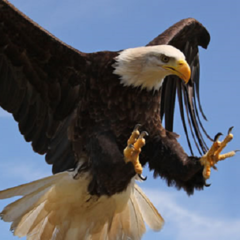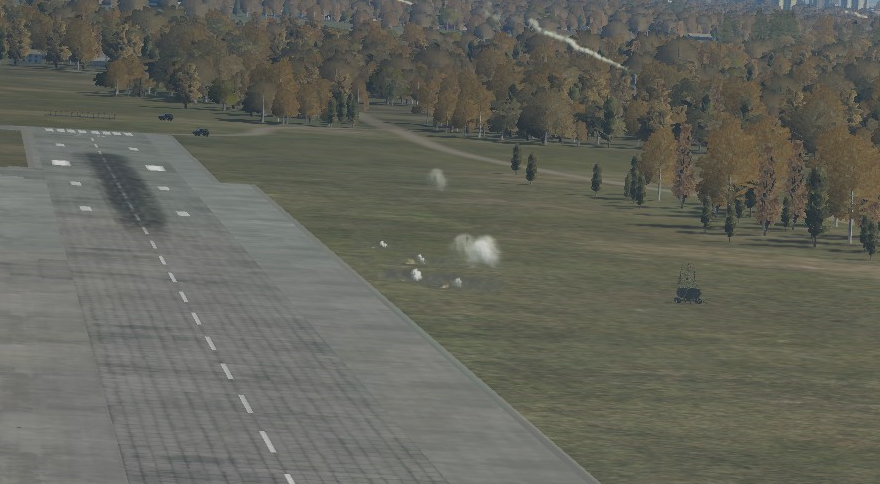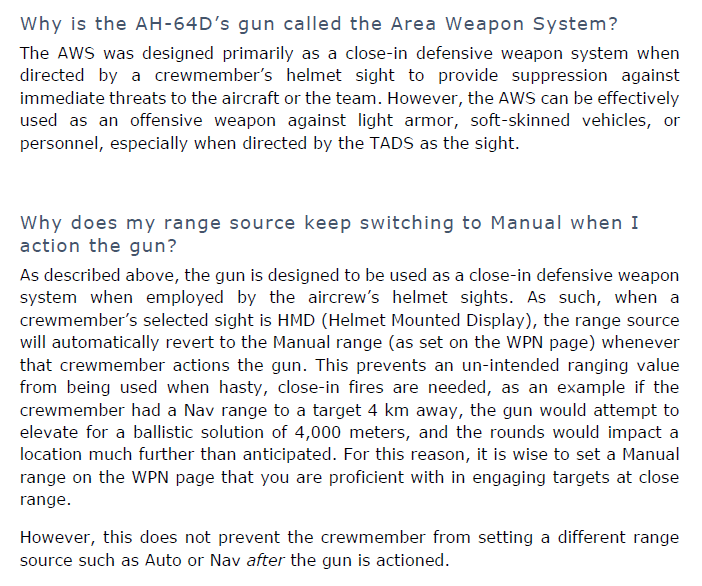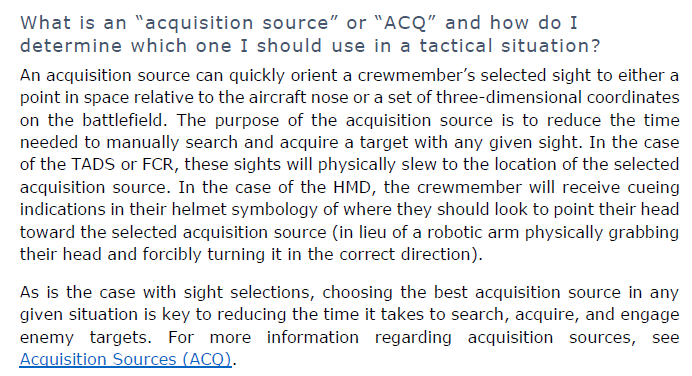-
Posts
2162 -
Joined
-
Last visited
-
Days Won
4
Content Type
Profiles
Forums
Events
Everything posted by Raptor9
-
There was also some modest embellishment in the book as well. Innocent, but a little cringey from points-of-view of others that are familiar with the subject matter. Not to diminish the service of him, or any of his colleagues he flew and fought with. But there were a few instances during my own read of the book I had an eye-roll and a chuckle.
-

reported Incorrect behaviour on YAW channel CAS function
Raptor9 replied to TZeer's topic in Bugs and Problems
@TZeer, you are correct on both counts. Both of these are also reported by the SME team, among other items of improvement as part of their flight model/FMC feedback. Per my usual disclaimer, I can't speak for the dev team, nor do I have any time estimate on these improvements. -

reported Incorrect behaviour on YAW channel CAS function
Raptor9 replied to TZeer's topic in Bugs and Problems
This has already been reported by the SME team. However, thank you for your attention. -
Flying helicopters is all about maintaining an attitude. Attitude determines direction and magnitude of velocity based on where you are offsetting the lift vector from the main rotor system. How well a helicopter pilot can maintain an airspeed/flight path is predicated on how well he can maintain a specific attitude. When performing an approach to landing in a fixed wing, you control speed by adjusting your pitch/AoA for speed with the stick and you control your flight path up or down with the throttle. Flying a helicopter is similar, in that you control your pitch attitude for speed with the cyclic, and you adjust your climb/descent with the collective. You can certainly use the cyclic to pull back into a climb or push over into a dive, but doing so will have drastic effects on your airspeed condition if maintained. So to answer your question: yes, you should be using the VSI to determine your climb/descent rate or to maintain level flight, and the flight path vector to gauge your virtual direction of flight. The horizon line is only used as an attitude reference relative to the LOS crosshairs, which is why it isn't placed virtually over the real-world "out-the-window".
-
The horizon line isn't a 1:1 scale ratio in pitch. When in Cruise mode, the horizon line/pitch ladder is a 2:1 scale ratio in pitch, and when in Transition mode the horizon line is a 4:1 scale ratio in pitch.
-
Thank you for the track. While the behavior within the track is not intended, the fix may be to limit the flare slider to 60 and the chaff slider to 30, to avoid this scenario. The intended use of the 30-round chaff bucket is meant solely for chaff, not flares. As such, during rearm operations, the countermeasure sliders should always be set to 30 for chaff and 60 for flares. I understand this may not be the resolution that some players may desire, but in the interest of accurate behavior of the module, there shouldn't be an ability to load more than 60 flares. EDIT: This appears to be fixed internally.
-

Where on IHAADS or TDS screen is distance to target shown?
Raptor9 replied to DmitriKozlowsky's topic in DCS: AH-64D
The only time that the CPG's range should be displayed in the Pilot's symbology is when the crew is in COOP rocket mode. Other than that, you would need to display the CPG's TADS video on an MPD to see what his range is. The current behavior of the CPG laser range showing in the Pilot symbology when ACQ is set to TADS is a bug that occurred in the past couple weeks, and has been reported. -
The original effect of the large column of smoke was incorrect. The M274 is a training rocket that simulates the M151 HE rocket but generates a small flash and brief smoke signature effect instead of an explosion. This was implemented in a recent patch and is intended behavior. The current M274 is using an M156 white phosphorous rocket external model, which is a target marking rocket that would generate a large smoke cloud for about 2 mins, but I believe it is being used as a placeholder for the time being, as are the current zone loading options. You can see the small signatures of smoke and impacts from several training rockets in this screenshot:
-
It's also rather amusing to see pretty much every carrier mission in DCS have a helicopter permanently hovering next to the carrier in formation with it. It's sort of one of those misconceptions that everyone thinks is true, partly because it's so commonly shown in video games and such. Aside from the fact a helicopter is burning fuel at a high rate doing that, it's also hanging out around the edges of the height/velocity "avoid" regions. Which isn't to say there isn't a "plane guard" helo close by during launch/recover operations, but maintaining a hovering formation with the carrier is sort of silly.
-
Brand new feature for the AH-64D that came out last week with the new George/Petrovich IFF functions.
-
George will zoom in if necessary to ID the target. If you want to have him manually zoom back in while the target list is still displayed, you can use Up Long to zoom in or Down Long to zoom out. This only works if the target list is displayed.
-
@Dallas88B, I do want to clarify that the new Flight Controls section contains specific criteria and conditions for how the hold modes should work, but there are some identified issues that are still being worked on to bring the module to where it needs to be. As usual, this will take time, but we'll get there.
-
Why would that be needed? The AGM-114 already performs as it should in that it destroys tanks.
-
It has the exact same HEAT warhead, just different guidance section. HEAT stands for High Explosive Anti Tank. This is explained in the manual. The manual is included in the install for your convenience. [DCS install]/Mods/aircraft/AH-64D/Doc It's bookmarked for each section so things are easy to find. Pressing Ctrl-F when using such PDF files allows you to search for key words to discover good info. The manual is a good source of information. It's where all the answers lie. It's where everyone else hangs out. One. Of. Us. One. Of. Us.
-
@Dallas88B, that will be where all the manuals are normally kept and updated for all the modules. Allows them to get pushed to the users during updating. Each module has a Doc folder for this purpose.
-
The manual was updated on the 20th of July with last weeks Openbeta. Check in your DCS install in the Mods/aircraft/AH-64D/Doc location.
-
Keep in mind that such high-caliber artillery isn't employed to provide the same density of flak as smaller calibers like 14.5mm, 23mm or even 57mm. These types of large-caliber AAA units would hold high-flying bombers at risk to disrupt their flight path to the target area. In the era that these systems were put into service, bombers were still performing carpet bombing at high altitudes with dumb bombs that required them to fly generally straight and level as they approached the target area, which would allow either the optical sights or the radar nav/bombardier to provide a good solution for when to release the bomb load. Couple the guns with a fire control radar that can direct their salvos at high altitude against a large, non-maneuvering bomber formation, and the only question that remains is how many guns do you need to cover the target you're defending, based on the number of expected enemy bombers to be over the target area within a given time span. While I do think 65 minutes to reload seems excessive, and I also agree that air defense units would probably stockpile additional rounds nearby for large strategic targets that aren't going anywhere, these guns aren't going to be the primary defense. Nor would they likely be employed against small maneuvering fighters if smaller caliber AAA emplacements were available that could provide faster rates of fire along with quicker traverse rates. I'm not speaking for the devs, just speaking on the topic of employment and tactics.
-

correct as is ACQ TADS Gun fires boresight when fired by pilot
Raptor9 replied to DmitriKozlowsky's topic in Bugs and Problems
@DmitriKozlowsky Here are some excerpts from the manual's FAQ section. Hopefully this will entice you to at least crack open the document to try to understand how the aircraft's targeting systems and avionics work. This is not a personal attack, it is meant as constructive feedback; you would probably have a much clearer understanding of your dilemmas if you had a foundational understanding of the how the aircraft works. -
This isn't correct behavior. The one and only time that the Pilot's range source mirrors the CPG's is if the CPG has actioned rockets on the TEDAC grip and the pilot has actioned rockets as well in COOP mode. Under these conditions, whatever the CPG's range source is (laser, nav, auto, manual, default) that range source/value will be mirrored in the Pilot's symbology. All other instances the range sources should always independent. Reported. Thanks.
-

Where on IHAADS or TDS screen is distance to target shown?
Raptor9 replied to DmitriKozlowsky's topic in DCS: AH-64D
@DmitriKozlowsky, you really really need to read the manual. Not only would that answer almost every single question you've posted in this sub-thread, but it would also prevent you from posting erroneous bug reports of correct behavior.- 18 replies
-
- 14
-

-

-

cannot reproduce and missing track file Gun misaligned for me since patch
Raptor9 replied to tn_prvteye's topic in DCS: AH-64D
The IHADSS boresight procedure hasn't changed since release. Without a track it is hard to troubleshoot if there is anything you are doing wrong, such as performing the procedure incorrectly or using an erroneous range setting. Also, I recommend trying it outside of VR. If you follow the same steps outside of VR and there is no issue, then it may be a problem with your VR setup. -
@NeedzWD40, in response to your question, only the K and L models are planned.
-
Nowadays, rocket pods are carried exclusively on the outer pylons, but Hellfires can be carried on the inner or outer stations. It was a lot more common to see both variations as you described prior to the mid-2000s. There is no impact to flight characteristics or maneuverability since a full rocket pod weighs roughly the same as a full rack of Hellfires (it could be slightly more or slightly less depending on what type of rockets are loaded in the pod). So no impact on roll moment or inertia by swapping one or the other. The reason rocket pods aren't loaded on the inner pylons nowadays is to reduce the possibility of hot gas ingestion into the engines when firing large salvos of rockets. But personally, I always assumed that such measures were based on rare instances of such effects under specific flight conditions, since AH-64s had been rocking the inboard rocket configurations for decades without any significant issues. But, I could be wrong.
-
I'll ask again but I would manage your expectations according to the current "not planned"




